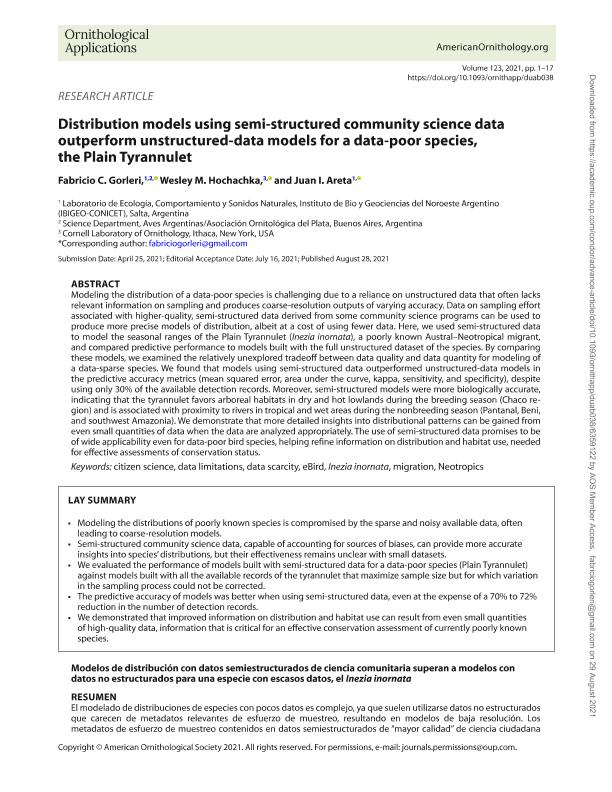Mostrar el registro sencillo del ítem
dc.contributor.author
Gorleri, Fabricio Carlos

dc.contributor.author
Hochachka, Wesley Michael

dc.contributor.author
Areta, Juan Ignacio

dc.date.available
2023-09-22T11:45:56Z
dc.date.issued
2021-11
dc.identifier.citation
Gorleri, Fabricio Carlos; Hochachka, Wesley Michael; Areta, Juan Ignacio; Distribution models using semi-structured community science data outperform unstructured-data models for a data-poor species, the Plain Tyrannulet; Cooper Ornithological Society; The Condor; 123; 4; 11-2021; 1-17
dc.identifier.issn
0010-5422
dc.identifier.uri
http://hdl.handle.net/11336/212636
dc.description.abstract
Modeling the distribution of a data-poor species is challenging due to a reliance on unstructured data that often lacks relevant information on sampling and produces coarse-resolution outputs of varying accuracy. Data on sampling effort associated with higher-quality, semi-structured data derived from some community science programs can be used to produce more precise models of distribution, albeit at a cost of using fewer data. Here, we used semi-structured data to model the seasonal ranges of the Plain Tyrannulet (Inezia inornata), a poorly known Austral-Neotropical migrant, and compared predictive performance to models built with the full unstructured dataset of the species. By comparing these models, we examined the relatively unexplored tradeoff between data quality and data quantity for modeling of a data-sparse species. We found that models using semi-structured data outperformed unstructured-data models in the predictive accuracy metrics (mean squared error, area under the curve, kappa, sensitivity, and specificity), despite using only 30% of the available detection records. Moreover, semi-structured models were more biologically accurate, indicating that the tyrannulet favors arboreal habitats in dry and hot lowlands during the breeding season (Chaco region) and is associated with proximity to rivers in tropical and wet areas during the nonbreeding season (Pantanal, Beni, and southwest Amazonia). We demonstrate that more detailed insights into distributional patterns can be gained from even small quantities of data when the data are analyzed appropriately. The use of semi-structured data promises to be of wide applicability even for data-poor bird species, helping refine information on distribution and habitat use, needed for effective assessments of conservation status.
dc.format
application/pdf
dc.language.iso
eng
dc.publisher
Cooper Ornithological Society

dc.rights
info:eu-repo/semantics/openAccess
dc.rights.uri
https://creativecommons.org/licenses/by-nc-sa/2.5/ar/
dc.subject
CIENCIA CIUDADANA
dc.subject
DATA LIMITATIONS
dc.subject
DATOS ESCASOS
dc.subject
DATOS LIMITADOS
dc.subject
EBIRD
dc.subject
INEZIA INORNATA
dc.subject
MIGRACIÓN
dc.subject
NEOTRÓPICO
dc.subject.classification
Ecología

dc.subject.classification
Ciencias Biológicas

dc.subject.classification
CIENCIAS NATURALES Y EXACTAS

dc.title
Distribution models using semi-structured community science data outperform unstructured-data models for a data-poor species, the Plain Tyrannulet
dc.type
info:eu-repo/semantics/article
dc.type
info:ar-repo/semantics/artículo
dc.type
info:eu-repo/semantics/publishedVersion
dc.date.updated
2023-09-15T12:59:54Z
dc.journal.volume
123
dc.journal.number
4
dc.journal.pagination
1-17
dc.journal.pais
Estados Unidos

dc.description.fil
Fil: Gorleri, Fabricio Carlos. Consejo Nacional de Investigaciones Científicas y Técnicas. Centro Científico Tecnológico Conicet - Salta. Instituto de Bio y Geociencias del NOA. Universidad Nacional de Salta. Facultad de Ciencias Naturales. Museo de Ciencias Naturales. Instituto de Bio y Geociencias del NOA; Argentina
dc.description.fil
Fil: Hochachka, Wesley Michael. Cornell Laboratory of Ornithology; Estados Unidos
dc.description.fil
Fil: Areta, Juan Ignacio. Consejo Nacional de Investigaciones Científicas y Técnicas. Centro Científico Tecnológico Conicet - Salta. Instituto de Bio y Geociencias del NOA. Universidad Nacional de Salta. Facultad de Ciencias Naturales. Museo de Ciencias Naturales. Instituto de Bio y Geociencias del NOA; Argentina
dc.journal.title
The Condor

dc.relation.alternativeid
info:eu-repo/semantics/altIdentifier/doi/http://dx.doi.org/10.1093/ornithapp/duab038
Archivos asociados
